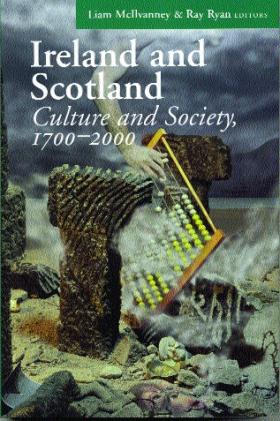Ireland and Scotland: culture and society 1700–2000
Published in 18th–19th - Century History, 20th-century / Contemporary History, Book Reviews, Issue 4 (Jul/Aug 2005), Reviews, Volume 13 Ireland and Scotland: culture and society 1700–2000
Ireland and Scotland: culture and society 1700–2000
Liam McIlvanney and Ray Ryan (eds)
(Four Courts Press, €55)
ISBN 1851828753
When Dominic Behan penned his little ditty
‘The sea, oh the sea, grá geal mo chroi,
Long may it roll between England and me.
God help the poor Scotsman, he’ll never be free.
Thank God we’re surrounded by water’,
he was reducing the differences between Ireland and Scotland to one of geographic fortune but simultaneously putting his finger on a complex and little-considered relationship. Irish nationalists—despite the Scottish origins of some of their luminaries—have been at best ambivalent and often hostile towards Scotland and its relationship to England. The Scots were seen to have sold out twice: first to the Reformation and later to the Union. They had planted Ulster and helped to repress the native Irish, and then, when push came to shove, openly colluded with the imperial designs of England.
Not a pretty picture. And it gets worse. Not content with repressing the Irish in Ireland, the first wave of Irish immigrants to America, mostly of Ulster origin, invented the term Scots-Irish to distinguish themselves from the mere Irish who flooded across the Atlantic in the wake of the Famine. Anatol Lieven, in his recent book on US nationalism, twists the knife yet again by locating the fundamentalist impulse in American politics—strategically exploited by G.W. Bush—in the Ulster-Scots community. He disposes of them by characterising them as believing in freedom—except for freedom of thought.
There is considerable baggage here. Most Irish historians deal with the problem by ignoring it, as in Diarmaid Ferriter’s recent book, The transformation of Ireland, which contains one passing reference to Scotland. In his chapter Cairns Craig makes a similar point about Declan Kiberd’s Inventing Ireland, where the binary nature of post-colonial theory seems to exclude consideration of the relationship with Scotland.
For most Irish people, then, Scotland is terra incognita, a place where sectarian animosities can be played out via Old Firm football matches. Indeed, it is difficult to define the mental map that the Irish have of Scotland. Most other countries are filed away under specific mental shorthand: Italy, Germany and France are subject to facile classification but Scotland defies easy encapsulation. Ulster Unionists have a similar problem. When threatened, they seek refuge in a Scottish heritage, but they are far from happy with the striking lack of unionist sentiment among the Scots. This book seems to confirm this feeling of absence.
The justification for putting the book together is the paucity of comparative studies, apart from the area of social and economic history. But this assumes that there is a story to tell based on a shared historical experience that is different enough to allow for elaboration. There are plenty of stories worth telling—a comparative study of the path to modernisation in Finland and Ireland springs to mind—but this is hardly enough to fuel even a small-scale academic industry.
Ireland and Scotland makes the case for investment in this area of academic endeavour. Clearly, the relationship with England is a defining element in the cultural and economic development of both countries, but this relationship is inflected by more direct interaction between them. As the case of the Ottoman and Hapsburg empires shows, the effects of imperial rule on subaltern cultures are often singular and unpredictable. In one sense, British rule can be seen as a political and economic carapace on the process of economic and social modernisation that took place from the eighteenth century onwards. With or without the interference of England, both countries would probably have embarked upon the same road to modernisation, and perhaps in a parallel universe there is a little Holland swimming smugly off the coast of mainland Europe.
What brings Ireland and Scotland together is a common cultural capital of language (and the loss of language), music and myth, and a similar historical experience. This substratum of historical experience does not always manifest itself in similar ways. The reality of the Union, as Jim Smyth points out, played out differently in both countries perhaps because when the Union was enacted in Ireland the political ideas and culture of French republicanism had already taken root.
In the final chapter of the book, T.M. Devine finds it strange that it is only in recent years that scholars have become interested in looking at the relationships between the two countries. But surely one of the objectives of imperial rule has always been to disrupt direct connections between the various parts of empire and reroute them through the centre. Edward Said in his autobiography writes convincingly of the problems of disconnecting from the discourse of empire and struggling to find an alternative. Post-colonial theory may disrupt the discourse of empire but often fails to connect elsewhere. This book could demonstrate that there is a fruitful arena of study to be found here that moves away from traditional Anglocentric obsession.
Jim Smyth
















